#coloratura mezzo soprano
Explore tagged Tumblr posts
Text
Rare footage of Conchita Supervía singing a Spanish song
This wonderful excerpt is taken from the 1934 film "Evensong'. Supervía sings "Los ojos negros" (Dark eyes) composed by Luis Barta.
#classical music#opera#music history#bel canto#composer#classical composer#aria#classical studies#maestro#chest voice#Los ojos negros#Dark eyes#Luis Barta#Evensong#Spanish song#Conchita Supervía#coloratura mezzo-soprano#mezzo-soprano#classical musician#classical musicians#classical history#opera history#history of music#history#historian of music#musician#muscians#diva#prima donna#Rare footage
6 notes
·
View notes
Text
nothing sad but i need to bitch and im tired and need to frow up
#someone's eating mcdonalds on the train. oh the guy next to me actually. i really am gonna throw up#anyway killing god for not giving me perfect pitch ig we're just doing some pathetic sight reading today#then again its not like the third lady is much more than pretty much just a continuous bass line but there are Words too and quite Fast#and idk why im so nervous about Not Being 100% prepared if none of these people ever do their fuckin job.#and i love the third lady more than anything but i do think its a bit of a dick move to make me learn the entire second lady part last time#when i literally begged for the third one. and NOW to be like 'you're doing third lady btw. oh and the queen of the night too btw'#and god i WISH it was because of my incredible primadonna assoluta skills and amazing vocal range lmao#but its just because those other teletubbies cannot be fucking trusted to learn their shit :)))))#the first lady is just. the melody obv so its hard to fuck that one up. and the second is the least important lets be honest#why im suddenly jumping to the queen in the finale is beyond me tho and like sure its nice to finally be allowed to sing a soprano part 🤡#but its so stupid. there's zero consideration for our voice types really. also im tired of doing everyone's job#'oh our zerlina didnt learn her part can you cover for her. oh the soprano is sick but we have a spare mezzo#so can you do norma instead of adalgisa today? yes i know you never sang it before. can you cover the cenerentola too next week?'#DO I LOOK LIKE A FUCKING HORSE#and most of all. do i SOUND like im a good fit for ANY of these roles really? 'oh you know idk what they're telling you but to me it sounds#like you're a beautiful lyric coloratura mezzosoprano' NO SUCH THING BUT THANK YOU.#'you're not a mediocre lyric soprano you're a magical unicorn that shits rainbows' this is what you sound like.#its not about my skills its about me knowing all this shit by heart and being willing to be used ig and it's just. god.#im not even getting paid for this 🤡🤡🤡🤡🤡🤡🤡
5 notes
·
View notes
Text
#ennio motherfucking morricone babyyy!!! #also listen to the ukulele orchestra of great britain's cover sometime tags by @thestuffedalligator

#Music#Westerns#The Good the Bad and the Ugly#Sergio Leone#Ennio Morricone#*fascinated*#The “Wah Wah Lady” as so called in YouTube comments is Tuva Semmingsen a Norwegian mezzo-soprano and coloratura#I'm especially fascinated by her voice#And now I wonder if “wololololol waw waw waw ayayayayaya waw waw waw” is the new “esos son rebook o son nike”
44K notes
·
View notes
Text
Celebrating the heavenly birthday of Mezzo Soprano Grace Bumbry (4 January 1937 - 7 May 2023).
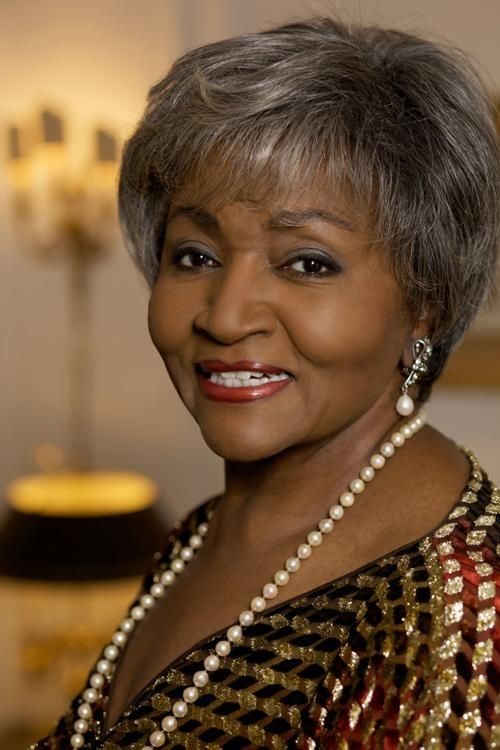
Grace was an extremely admirable person and artist. Alongside Marian Anderson and Leontyne Price, break down the color barrier in opera. Conquered international acclaim in 1961 after performed at the Bayreuth as - how the press noticed - "Black Venus" in Wagner's Tannhauser. Withi Joan, she recorded the mezzo part in Händel's Messiah (1961) and with Birgit, her canonical role, Amneris in Aida (1967).
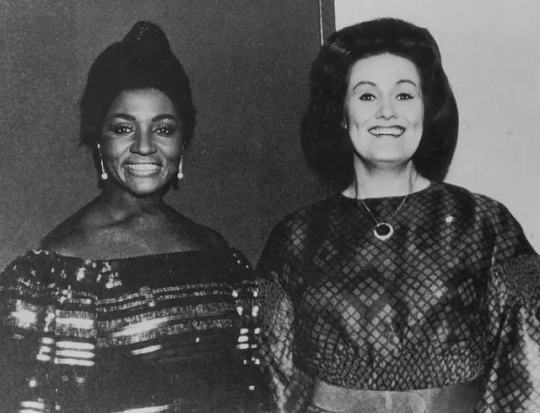
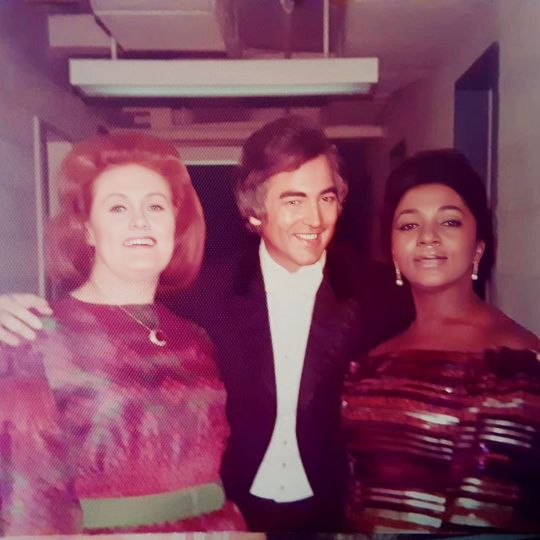
📷 Grace poses with Joan and Richard in the occasion of Bing's Met Farewell, 1972.
#mezzo soprano#mezzosoprano#gracebumbry#classicalmusic#opera#operasinger#operahouse#baroque#belcanto#maestro#pianist#richardbonynge#dramatic#coloratura#soprano#dame#joansutherland#lastupenda#diva#primadonna#1970s
1 note
·
View note
Text
dropping my les amis voice part headcanons because no one can stop me (gonna call this les amis de l'SATB)
enjolras is a pure tenor because of course he is
courfeyrac is a baritenor who can sing kind of high and kind of low but neither all that impressively
combeferre is a BASS like a patrick page in hadestown kind of bass and no one can take bass!ferre away from me ever
feuilly is also a bass meaning he can't sing high to save his life, but he also can't sing as low as ferre can and he's perpetually a little bit salty about it
jehan is either a pure countertenor (when AMAB) or a pure lyric coloratura soprano (when AFAB). doesn't matter what gender they are they just sing really high ok
joly is a baritone, decent high range and decent low range, but the lower he sings, the more his scottish accent slips out (will make a full post about scottish!joly later cos i have feelings about this man)
bossuet is a tenor :)
musichetta is one of those really low altos who sings tenor half the time she has such a rich and warm voice quality, like the kind of alto that would make me (a soprano with a horseshit low range) go weak in the knees like aaaaahhhhhhh (her voice also blends really well with those of joly and bossuet so whenever they sing together it basically makes everyone around them want to melt (myself included))
eponine is also an alto but on a really good day she can belt into A4-E5 range (she can't sing as low as musichetta can though)
cosette is one of those classic musical theatre high-belt mezzos who can't sing as high as well as they should be able to, kinda like christy altomare in anastasia
azelma is a soprano but doesn't really care that she's a soprano and typically sings mezzo parts
maruis is a tenor with a vocal range very similar to his in the musical like tell me this man doesn't perfectly fit the dorky tenor stereotype
i think that's all of them let me know if i missed anyone
edit because i forgot bahorel: bahorel is a bass, similar voice quality to feuilly, but can sing both ever so slightly higher and ever so slightly lower than him. poor feuilly
edit again because turns out i also forgot grantaire: he's a low tenor, not much else to say about this, but he can belt to the high heavens (and mostly chooses not to)
#les mis#les miserables#i'm not gonna tag all of les amis i don't have the energy for that rn#<- says someone who literally just typed a whole ass essay#whatever#les amis de l'abc#les amis
64 notes
·
View notes
Text
What vocal types I think the TMI cast would have in TMI musical:
Clary: Coloratura Mezzo-Soprano
Jace: Lyric Tenor
Simon: Leggaro Tenor
Isabelle: Dramatic Mezzo-Soprano
Alec: Spinto Tenor
Magnus: Verdi Baritone
Maia: Lyric Mezzo-Soprano
Raphael: Baryton-Martin Baritone
Sebastian: Dramatic Tenor
Camille: Dramatic Soprano
Lily: Dramatic Contralto
Bat: Dramatic Baritone
Max: Treble
Meliorn: Countertenor
Aline: Lyric Contralto
Seelie Queen: Spinto Soprano
Jordan: Lyric Tenor
Maureen: Treble
Catarina: Coloratura Mezzo-Soprano
Ragnor: Verdi Baritone
#shadowhunters#the shadowhunter chronicles#tsc#tmi#the mortal instruments#clary fairchild#jace herondale#simon lewis#isabelle lightwood#alec lightwood#magnus bane#maia roberts#bat velasquez#lily chen#raphael santiago#sebastian morgenstern#camille belcourt#maureen brown#max lightwood#meliorn#aline penhallow#jordan kyle#seelie queen#catarina loss#ragnor fell#a bass in my tmi musical? more unlikely then you’d think#legitimately kinda sad I can’t see any of these characters being basses cause I love lower range songs#shadowhunter musical
37 notes
·
View notes
Text
I used to find her voice annoying when I was little, but after enjoying nearly 15 years of being professionally trained to sing mostly classical-style music theater and opera as a light lyric coloratura soprano, my singing voice definitely is most similar to Adriana Caselotti’s (Snow White) and Mary Costa’s (Aurora’s). I’ve also grown to hear the beauty in Snow White’s as I’ve gotten older, and I also realize Adriana Caselotti deliberately played up that babyish quality to her voice as Snow White to make it sound more childlike and innocent for the sake of the role. She definitely is still up there as the animated Disney Princess with the most legit classical-soprano vocal range and technique. I think she goes up to a D6 vocal trill in the dwarves Silly Song. Her highest full note is the B5 in Whistle While You Work, though.
youtube
Mary Costa (Aurora) has a bit more of a mature full lyric soprano voice than Adriana Caselotti as Snow White, nor does she use as much coloratura vocal technique in her runs and trills. However, she still has a bright and warm tone and technique that is most definitely legit classical lyric soprano. I think she goes up to an A5, and goes down to a D4.
youtube
Cinderella (Ilene Woods) is closer to a true contralto with a range of A3-Bb4. She has a darker, dreamier, and warmer quality to her voice that fits her longing nature
youtube
Jodie Benson(Ariel) technically has a light lyric soprano timbre, but she only goes between a C4-D5 as Ariel. That’s totally a doable sweet spot for a mezzo. Plus, she doesn’t really use any legit classical soprano technique. Ariel’s a light soprano belter.
youtube
In the second movie, she shows off more of her classical soprano chops in “Down To The Sea” and “For a Moment.” She goes up to at least an F5.
Paige O’Hara (Belle) goes between a low G3-to an Eb5 in the animated Disney movie, and she definitely has the solid middle timbre of a mezzo-soprano belter. It’s clear, full, and warm in the middle. Whereas Ariel can technically be sung by a mezzo-soprano quite easily, the actress who voiced her definitely has the bright, silvery, and youthful timbre of a lyric soprano. She only goes up to a D5 in the 1989 animated film, but you can tell that Jodie’s voice starts to naturally soar once she gets past the middle. Paige is definitely a natural mezzo-soprano, though.
youtube
Jasmine (Lea Salonga) is definitely a mezzo-soprano. You can tell this because she had to sing “Think of Me” from Phantom of the Opera in a lower key. However, she definitely is a lighter mezzo soprano with a slightly higher timbre.
youtube
Pocahontas (Judy Kuhn) is very much a mezzo-soprano with a range of G3-Bb4 in Colors of the Wind.
youtube
Megara (Susan Egan) from Hercules sings between a G3-C5, which is very much a mezzo soprano’s sweet spot. I also love how she added this cynical and sarcastic edge to Meg’s voice that goes away the more she falls in love with Hercules.
youtube
Mulan (Lea Salonga) is also a lighter mezzo, much like Jasmine, which makes sense since they share the same singing voice. I really do love how Lea got to show off her voice more in Mulan than she did in Aladdin because it is lovely. It makes me want to cry with her when she sings the chorus so sadly. I think she also goes up to an E5 in this song.
youtube
Rapunzel (Mandy Moore) is a soprano with a vocal range of G3-G5, and a more bright and youthful timbre. However, like most modern day Disney sopranos post the Golden age, she is a soprano-belter, so she is doable for a mezzo with a more developed upper register.
youtube
The Ranges of Disney Princesses. AKA, the case for the mezzo princess.
We all hear that the Disney princesses are all sopranos, and that this sucks. “When will we get an alto princess?!” is a phrase I constantly hear. Well, I wanted to set down the facts for all to see. Let’s look at the ranges. Note that all are based on the movie songs, not the musical versions when applicable. Let me know if I missed something, or want me to check a song again. I cross-checked sheet music to videos, but I could have missed something.
Snow White: D4-Bb5
Anna: Gb3-G5
Rapunzel: G3-G5
Aurora: D4-F5
Pocahontas: G#3-F5
Jasmine: C#4-E5
Elsa: F3-Eb5
Mulan: G#3-D5
Tiana: G#3-C#5
Ariel: C4-C5
Belle: G#3-B4
Cinderella: A3-Bb4
So we see some sopranos here–Snow White and her little operatic runs are, undoubtedly, soprano territory. But from there, we pretty quickly drop off from true soprano territory and fall smack-dab in the middle of mezzo-land. Anna and Rapunzel, sure, may be tough for some mezzos who don’t have a developed upper range. But as you move down that list, we’re suddenly getting down to notes that I know many sopranos cannot sing. I have lots and lots of students who cannot consistently sing a G#3, so it’s tough to argue that these ranges are unreasonably soprano-esque. In fact, we get to Ariel who has a downright tiny range. Crazy, right! Cinderella, Belle, and Ariel would really be considered more of altos if we just look at their ranges!
But many people hear these songs and immediately think, but they’re so high! And this is where timbre comes into play. Some of these women have very light timbres, and it makes their voices sound higher than they actually are. It’s shocking to really take a look at how low some of these songs actually are, right?
I actually feel like amongst all these characters, there’s a pretty great representation across many ranges and types. We’ve got belters, legit singers, more operatic, more mixed, more pop… Ranging all the way from an F3-Bb5 altogether! Represent, female voices.
#Youtube#I’m a classically trained light lyric coloratura soprano and I’ve learned to sing many opera pieces before#yes in opera singing sopranos are the most common voice types for female singers#when it comes to singing in pop culture though most female singers are mezzo belters#that includes the Disney princesses#Snow White (Adriana Caselotti) was very much a classically trained high coloratura soprano with operatic trills#Aurora (Mary Costa) was a lyric soprano who used classical/operatic technique#aside from those two every other Disney Princess is a mezzo or a soprano belter voice that can be sung by a mezzo with a strong upper regist#Ariel#Cinderella#snow white and the seven dwarfs#Anna#Elsa#Mary costa#Adriana caselotti#I wish there were more classical/operatic sopranos in Disney Princess films#apparently people never thought that was voice was cool enough to appeal to fans in pop culture though
2K notes
·
View notes
Text
All right, DS9 fans who are opera freaks
For the 3 of you on tumblr, @currymuttonpizza and myself got chatting and one thing led to another and Badda-bing, Badda bang, we came up with the Fächer of the characters for the Opera version of DS9. Here goes
Captain Sisko: Bass Baritone. This seems self explanatory
Jake Sisko: countertenor
Major Kira: Coloratura mezzo. I may have been biased for this one bc that is the closest thing to my fach, but think Rossini‘s heroines, or some of Vivaldi‘s work (like Armatae Face et Anguibus from Juditha Triumphans)
Gul Dukat: also Bass-baritone, but of the villainous variety. Think Samuel Ramey as Reverend Olin Blitch in Susannah, or the titular role in Don Giovanni
Julian Bashir: Tenor leggiero. This also seems self explanatory
Kai Winn: originally I thought of a mezzo a la Ježibaba, but I think actually this may be a place for a villainous contralto
Jadzia Dax: mezzo, but of the type that delves down in contralto territory periodically (a la Avery Amereau ❤️)
Odo: dramatic baritone— to use @currymuttonpizza‘s inimitable phrasing “He's like if Scarpia were a good person idk.”
Worf: Bass, nuff said
Miles: baritone. Mostly an Everyman lyric kind but can venture in dramatic territory when he’s Suffering (he’s basically Wozzeck, if you think about it)
Keiko: sweet, loving, badass, sassy when needed? A soubrette, of the Mozart variety, a la Susanna and Zerlina
Garak: Britten tenor
Quark: dramatic baritone. Basically Alberich in space
Rom: Basso buffo
Nog: the guy you think is a tenor buffo, but is actually a Helden tenor
Kasidy Yates: full lyric soprano
Weyoun: tenor buffo. Complete Don Basilio type
Brunt: also tenor buffo. Both played by combs who brings buffo energy to both
Ezri: soubrette
Leeta: high poppy squeaky coloratura soprano (I’m thinking Olympia in the doll aria)
Damar: baritone, maybe slightly romantic but pretty run of the mill
Ziyal: light lyric soprano, ala Gilda from Rigoletto
Joseph Sisko: Dramatic Bass
Female Changeling: contralto, think Erda
Moogie: mezzo a la Marcelina from Nozze, but also some Despina vibes
Grand Nagus Zek: gonna trust @currymuttonpizza on this one, heldentenor like the drum major, but make it funny
Vedek Bareil: speaking role
32 notes
·
View notes
Text
eternally thinking about the opera adaptation that lives in my head and thinking about vocal roles. have some Stark-and-Stark-adjacent thoughts. if you disagree please tell me your thoughts.
Brandon: dramatic baritone, maybe specifically a Verdi baritone. probably would not actually have a role because he's dead.
Ned: spinto tenor, or maybe a dramatic tenor. big male lead energy right up until he gets killed. hey, it's opera.
Cat: dramatic soprano. I need that woman singing an aria during the Red Wedding, and I need her to sing "No, not my hair, Ned loves my hair" and make me cry real tears.
Lyanna: lyric soprano. she definitely gets to appear as a ghost and sing an aria at Ned.
Benjen: uhhhhh idk. light baritone. I really have very few Benjen-related thoughts.
Robb: tenor. probably a lyric tenor, possibly tenore di grazia. absolutely must be hitting that high C. like his father, big male lead energy ~and then he dies!~
Jeyne: lyric soprano. probably light rather than full, she's pretty young. duets with Robb, but maybe doesn't have an aria of her own.
Sansa: soprano. obviously. there is no other voice appropriate for an ingenue. probably a lyric coloratura, maybe a spinto, but she gets some dramatic passages in her arias so she'll need a strong voice.
Arya: dramatic mezzo. when she disguises herself as a boy she'll have some passages in a lower register, so she has to be able to handle those as well as some higher passages.
Bran: I contemplated this one for a while; I could justify making this a trousers role, but I think ultimately spinto tenor is a good choice. he'll have some dramatic passages while he's with Bloodraven having his greenseer training so he needs a strong voice.
Rickon: soprano because he's a baby.
Jon: dramatic tenor. I went back and forth between tenor and baritone, heroic tenor/noble baritone/lyric baritone were all ranges I considered, but really I think a dramatic tenor will suit him. does not hit that high C that Robb does.
+ bonus Jeyne Poole: also a soprano, this time a soubrette. She gets an aria while in Ramsay's clutches.
+ bonus Theon Greyjoy: heroic tenor. there is no doubt in my mind, he gets the Wagner-main-character voice.
+ + bonus Reek: castrato
#sansa stark#theon greyjoy#robb stark#jon snow#catelyn stark#arya stark#bran stark#rickon stark#jeyne poole#jeyne westerling#ned stark#brandon stark#lyanna stark#benjen stark#to be clear my reek casting is a joke of course he will still have theon's heroic tenor
10 notes
·
View notes
Text
coloratura is a type of vocal technique - i'm sure the technique exists in various forms in multiple other types of music (a 'melisma' in western classical music is the same thing as a 'run' in western pop music, for example), but i'll just speak to bel canto technique as that's what i'm familiar with (the standard technique for singing western opera and art music)
coloratura singing means 'colorful' (roughly), and it's called that because it is very heavily ornamented - lots of trills, lots of notes, lots of fast movement. because it moves fast, it's normally associated with lighter, more agile voices - the heavier/darker/more dramatic a voice, the harder it's going to be to move it fast, because the heavier/darker sound comes from thicker vocal cords, and the thicker your vocal cords are, the harder it's going to be to move between notes quickly. that's a surface explanation but it gets the point across
thinner vocal cords also tend to be able to vibrate at faster rates which means they tend to have a higher tessitura (comfortable vocal range). that's why you'll see a lot of coloratura in music for sopranos, because sopranos have the highest tessitura of all the basic voice types (bass, baritone, tenor, contralto, mezzo-soprano, soprano, from lowest to highest). it's not the only reason that coloratura tends to go to soprano arias, but it's a big one - the other reasons have a lot to do with western ideas of femininity and insanity
that being said, coloratura isn't exclusively the provenance of sopranos - you see a lot of it in baroque music (händel, for example). now, i'm actually not a big fan of baroque opera, because it's super repetitive, but fortunately for me, as a soprano, i have LOTS of potential coloratura repertoire in later styles
one of the most famous examples of a coloratura aria is der hölle rache from the magic flute by mozart, aka the queen of the night's aria (she has multiple but that's the famous one). lots of fast little notes very high up. (accidentals are also common.) other good examples are les oiseaux dans le charmille (the doll song) from les contes d'hoffman (offenbach) and il dolce suono (lucia's mad scene) from lucia di lammermoor (donizetti). you can also hear some coloratura in more modern work like andrew lloyd webber's the phantom of the opera - christine and carlotta in particular, although that score isn't super coloratura-heavy. glitter and be gay is also a coloratura aria
sometimes people will refer to 'coloratura soprano' as a voice type - they generally mean 'lyric coloratura soprano,' which is just a lyric soprano with an agile voice. like i said, there is a biological component to how easy coloratura is for someone to learn (although it is a learnable skill, it's not an innate one), and sometimes people will use 'coloratura' as a label for a voice type to mean that voice is agile/well suited to coloratura singing
my wips as arias i've sung
i'm procrastinating on a project so here we go! this is all specifically arias, not art songs, because i had to narrow it down lol. also, many of these wips are Not in a position to be posted but they're vibes
dark lord wip: regnava nel silenzio from lucia di lammermoor. as i've said in the tags of posts about this series, let's get some donizetti up in this bitch!! long, somewhat macabre, and features the star of the show doing Way Too Fucking Much. also, set in scotland lmao
icarus wip: song to the moon from rusalka. it's about the yearning. also the retelling of a folk tale or myth. the lonely sense of appealing to the heavens
bitter roses wip: ach, ich fühl's from the magic flute. magical and driving towards death (even though that's not what happens in the opera). ends not with a bang but with a grim prediction
silver lace wip: glitter and be gay from candide. flashy and fun, but the meter changes around on you and you might get hit with phrases you don't expect. also, JEWELRY AND GLITTER
#woooo music infodumping#heather would be a lyric coloratura soprano#maeve lyric soprano obsessed w pants roles#marlene mezzo also obsessed with pants roles
11 notes
·
View notes
Text
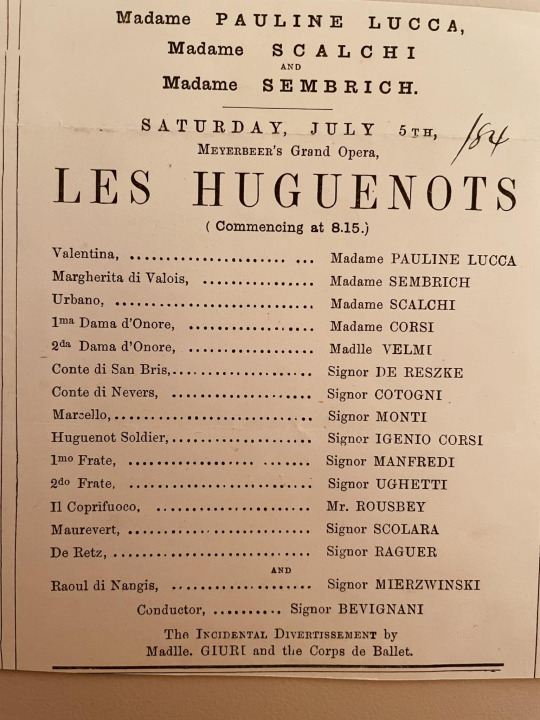
This is another 140 years old original castlist from the Royal Opera Covent Garden 1884. Meyerbeers Opera „Les Huguenots“ Look this great cast!
#classical music#opera#music history#bel canto#composer#classical composer#aria#classical studies#maestro#chest voice#Royal Opera House#Covent Garden#Les Huguenots#Giacomo Meyerbeer#Pauline Lucca#dramatic soprano#soprano#Sofia Scalchi#contralto#mezzo-soprano#Marcella Sembrich#dramatic coloratura soprano#The Nightingale#classical musicain#classical musicians#classical history#opera history#history of music#historian of music#musician
4 notes
·
View notes
Text

Despite Diva!Priscilla’s vocal range during her prime in the opera Fach system is Lyric Soprano (Mimi, Countess Almaviva, Pamina) & Dramatic Coloratura (Queen of the Night, Violetta, Lucia)…
I like to imagine our darling operatic songbird had some fun & unexpected roles along the way as well.
While re-listening to Le Nozze Di Figaro again… and given Priscilla’s penchant for donning pants …
I think she would have made a great Cherubino. A “pants role” where a woman plays the role of a teenage boy in an opera xD Cherubino is such a funny role in the opera and is always at the wrong place at the wrong time! (sound familiar?)
Maybe early in her career while she was still Soubrette and she was an understudy for Susanna (Figaro’s fiancée in the same opera)… the show must go on happened and she stepped in for a very unexpected cover for a mezzo-soprano playing Cherubino and without an understudy.
2 notes
·
View notes
Text
A Sword & a Caress. Few rate the Callas voice as opera's sweetest or most beautiful. It has its ravishing moments. In quiet passages, it warms and caresses the air. In ensembles, it cuts through the other voices like a Damascus blade, clean and strong. But after the first hour of a performance, it tends to become strident, and late in a hard evening, begins to take on a reverberating quality, as if her mouth were full of saliva. But the special quality of the Callas voice is not tone. It is the extraordinary ability to carry, as can no other, the inflections and nuances of emotion, from mordant intensity to hushed delicacy. Callas' singing always seems to have a surprise in reserve. With the apparently infinite variety of her vocal inflections, she can keep the listener's ear constantly on edge for a twist of an emotional phrase, constantly delighted by a new and unexpected flick of vocal excitement. Quite apart from the quality of her voice, her technique is phenomenal. The product of the relentless discipline that characterizes everything she does, it enables her to ignore the conventional boundaries of soprano, mezzo-soprano and contralto as if they had never been created. She can negotiate the trills and arabesques of coloraturas as easily as she trumpets out a stinging dramatic climax. Like her operatic sisters of a century ago, La Callas can sing anything written for the female voice. Because of her, La Scala has revived some operas (Mozart's Abduction from the Seraglio, Verdi's Sicilian Vespers, Cherubini's Medea) that it had not staged for years because no modern diva could carry them off. Blood & Tears. As actress. Callas is more exciting than any singer has a right to be. Her acting takes the form of a flashing eye that petrifies an emotion, a sudden rigidity that shouts of a breaking heart, a homicidal wish or a smoldering passion ("It takes nerve to stand still"). Callas' style of movement on stage strangely resembles the striding and lurching of the hamhearted operatic actress, but she moves so gracefully, so alluringly, with such authority, that even opera's baroque gestures take on breathtaking conviction. In her first Aida at La Scala in 1950, she startled the crowd by stalking about like a hungry leopard instead of taking the usual stately stance for her Act III duet. In the death scene of Fedora, in which sopranos tend to expire stiffly on a divan, Callas staggers from it, sags to her knees, drags herself up, crawls towards her lover's room, collapses again before she finally rolls down and dies. In Norma she has cried real tears. Operagoers, long reconciled to the classic, three-gesture range of other prima donnas, are astounded and delighted.
Music: The Prima Donna, Monday, Oct. 29, 1956 issue of Time Magazine
21 notes
·
View notes
Text
#tbt Back to 1977, after a concert with mezzo Huguette in Netherlands, Joan was received by the Princess Margriet of the Netherlands and her husband Pieter Van Vollenhoven.
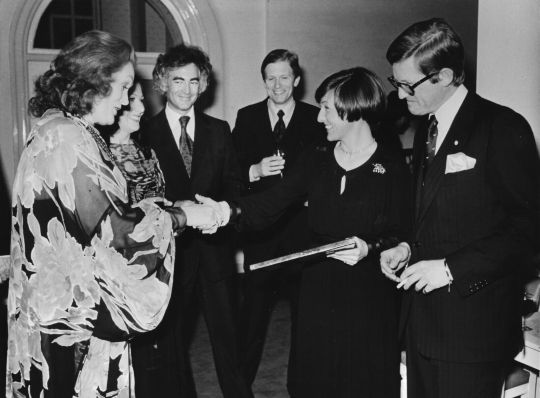
#soprano#classicalmusic#opera#dramatic#primadonna#diva#belcanto#coloratura#joansutherland#lastupenda#1970s#pianist#conductor#richardbonynge#mezzo soprano#huguettetourangeau#princess#princess margriet#concerto
0 notes
Note
As a fellow opera enjoyer, I've been wondering: do you have opera voice type "headcanons" for your ocs? And do you want an excuse to share them?
YES! i do actually! sorry, this took a little longer to answer because i wanted to draw little headshots of the others because they Lack Proper Refs at the moment— and it’s just nice to put a face to a name!
yap warning ‼️ starting with cecilia, she’s a soprano. obviously. one look at her story and it just YELLS tragic soprano lead. maybe a coloratura soprano? i could also see her having some pretty cool rage arias.
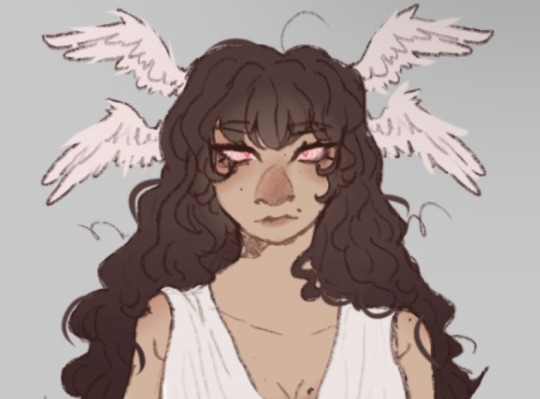
just look at her. the face of a girl capable of rage arias.
next i have the three girls from “letters to maya”!!! i see maya as being a mezzosoprano honestly, nothing specific pointing toward it, just just vibes based. vera actually has a canon voice type, she’s a contralto, and she actually wanted to take up the operatic path at one point— but ended up continuing with ballet because of her parents’ choices earlier in her life. i’m actually not sure about lilou. maybe a mezzo as well?
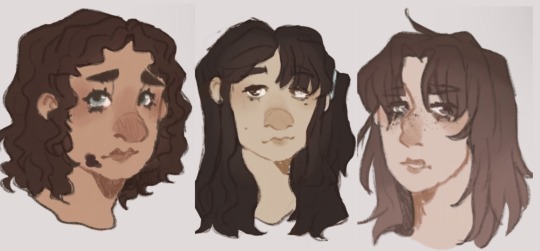
from left to right, maya, vera and lilou :)
as for the sisters of „final cries to a tainted heart”, i see circe as a mezzo and amalia as a soubrette!
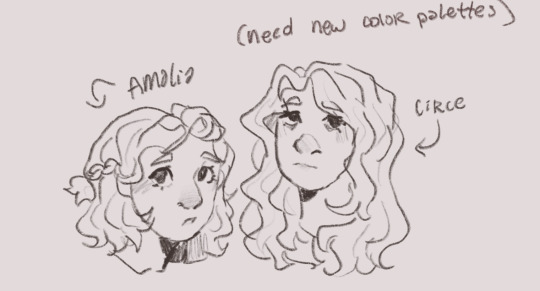
unfortunately i’m currently redesigning their color palettes but here they are!
this is such a fun ask…. i do have more ocs but they’re not in a story (avery, affy) or they are merely a concept right now (duchess prone to conniptions who STILL remains nameless at the moment.)
#oc asks#thank you!#ash talks#now to tag them all;#cecilia#maya#veronika “vera”#lilou#circe#amalia#tidbits and trivia :)
6 notes
·
View notes
Text
Fancasts for "An Eternal Crown: The Opera"
I'm being silly now and imagining what it would be like if my gender-bent Magic Flute retelling, An Eternal Crown, were adapted as an opera itself. It could be a "jukebox opera," consisting partly of music from The Magic Flute transposed, and partly of other music – for example, some of Handel's florid bass arias to take the place of the Queen of the Night's arias for King Vorteyo.
Sarisa and Zeran's voices I imagine as essentially Pamina's and Tamino's, since they are those two in reverse: a lyric soprano and a light lyric tenor. Lorikeet I can't help but imagine as a lyric coloratura. Vorteyo would be a bass, Alesta and Imara both motherly mezzos, Kimzi one of those roles like Zerlina that can be sung either by a soprano or a light mezzo, and Robin a lyric baritone. The Three Warriors I picture as a "heroic" Italian-style spinto tenor, and a baritone and bass in more of a Mozartean vein.
These are some of the singers I think might have been good in the roles in different eras:
An Eternal Crown: The Opera, circa 1960-1965
Sarisa: Irmgard Seefried or Gundula Janowitz
Zeran: Fritz Wunderlich or Nicolai Gedda
Lorikeet: Lucia Popp
King Vorteyo: Cesare Siepi
Alesta: Maureen Forrester
Kimzi: Teresa Berganza or Graziella Sciutti
Robin: Hermann Prey or Theodor Uppman
Imara: Marga Höffgen
Three Warriors: Giuseppe di Stefano, Eberhard Wächter, Fernando Corena
An Eternal Crown: The Opera, circa 1980-1985
Sarisa: Ileana Cotrubas
Zeran: Francisco Araiza or Peter Schreier
Lorikeet: Kathleen Battle
King Vorteyo: James Morris
Alesta: Marilyn Horne
Kimzi: Teresa Stratas
Robin: Håkan Hagegård, or a young Alessandro Corbelli
Imara: Janet Baker
Three Warriors: José Carreras, Thomas Allen, Samuel Ramey
An Eternal Crown: The Opera, circa 2000-2005
Sarisa: Ana María Martínez or Dorothea Röschmann
Zeran: Charles Castronovo
Lorikeet: Diana Damrau
King Vorteyo: Samuel Ramey
Alesta: Denyce Graves
Kimzi: Cecilia Bartoli
Robin: Rolando Villazón (it could have been an early light baritone foray for him)
Imara: Stephanie Blythe
Three Warriors: José Cura, Simon Keenlyside, Ildebrando d’Arcangelo
I'll think of more in the future.
8 notes
·
View notes